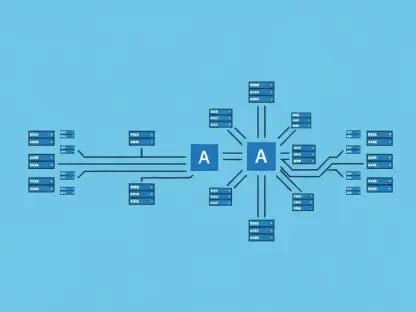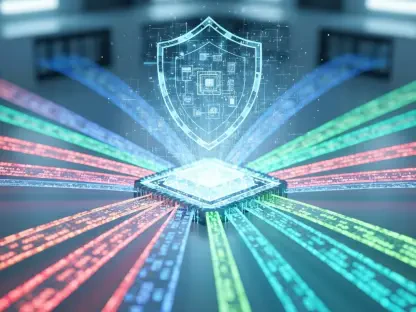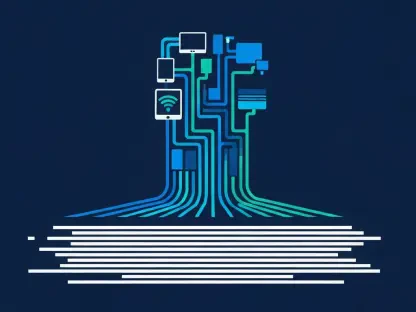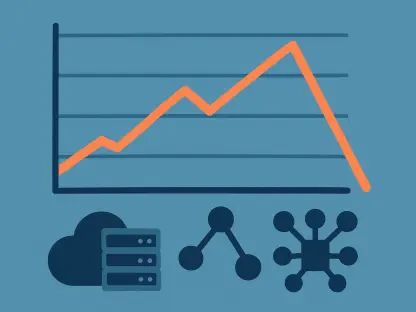The landscape of network security is in a constant state of flux as businesses strive to contend with the rising tide of cyber threats. By 2030, the global Network Security Market is anticipated to reach an impressive USD 90 billion, driven by a robust compound annual growth rate (CAGR) of 12.6% starting in 2024. Several factors contribute to this growth trajectory, not least the increasing complexity and frequency of cyber threats, which propel enterprises to invest more heavily in sophisticated network protection solutions. As the digital environment evolves, it is critical to understand the impactful trends currently shaping the future of network security.
Remote Work and Cloud Adoption: A New Era of Security
Complex Security Challenges in a Remote Workforce
The widespread shift toward remote work has redefined the perimeter of enterprise networks, leading to an array of complex security challenges. As the boundaries between personal and professional spaces blur, traditional security protocols are often rendered inadequate. There is a growing necessity for enterprises to adopt more sophisticated solutions that can protect sensitive data while ensuring business continuity. This has given rise to a surge in demand for cutting-edge security measures capable of effectively managing decentralized work environments and the unique vulnerabilities they present.
Cloud adoption, meanwhile, continues to climb, further complicating the security landscape. As organizations increasingly deploy cloud-based applications and services, they must navigate a variety of risks, from data breaches to unauthorized access. Companies are finding it essential to implement comprehensive security frameworks that not only guard against potential threats but also maintain compliance with complex regulatory standards such as GDPR and HIPAA. Adherence to these stringent regulations is not only crucial for the protection of sensitive data but also imperative to avoid costly legal penalties.
IoT Devices and Their Influence on Security Protocols
The proliferation of Internet of Things (IoT) devices adds another layer to the ongoing security challenge. As IoT devices become integral to everyday operations, businesses must reconsider their approach to network security. The interconnected nature of these devices results in heightened vulnerabilities, requiring a reevaluation of existing protocols. Advanced security strategies are necessary to protect these networks from exploitation by cybercriminals, who increasingly target IoT devices due to their often lax security measures and inherent weaknesses.
Efficiently managing security across these diverse devices demands an innovative blend of technologies such as artificial intelligence (AI) and machine learning (ML). These technologies play a pivotal role in enhancing threat detection capabilities, making it possible to respond dynamically to both known and unknown vulnerabilities. AI and ML allow for real-time monitoring, predictive analytics, and anomaly detection—crucial components for a robust security posture in the face of evolving threats. By leveraging these technological innovations, businesses can better safeguard their data and maintain the integrity of their operations.
Technological Advancements and Regulatory Compliance
Artificial Intelligence and Machine Learning as Game Changers
AI and machine learning are rapidly becoming indispensable tools in the cybersecurity arsenal, offering advanced threat detection and prevention capabilities. These technologies enable enterprises to predict and mitigate risks with greater precision, providing real-time insights into potential vulnerabilities. The integration of AI and ML into network security protocols has led to significant improvements in anomaly detection, enabling businesses to identify suspicious activities faster and more accurately than ever before.
The power of these technologies is further enhanced when combined with behavioral analytics, which provides a deeper understanding of user and system interactions. This combination allows for tailored security strategies that address specific threats while minimizing false positives. Despite the complexity of deploying AI/ML solutions, the benefits they bring in terms of enhanced security and operational efficiency are undeniable. Their ability to adapt rapidly to new and emerging threats is essential in the constantly evolving digital landscape, ensuring that organizations remain one step ahead of potential cyberattacks.
Meeting Compliance Demands to Fortify Security
Compliance with regulatory frameworks is a key driver of increased security measures in the network security market. Enterprises must navigate a complex web of global regulations designed to protect consumer data and ensure privacy. Compliance with regulations such as the General Data Protection Regulation (GDPR) and the Health Insurance Portability and Accountability Act (HIPAA) is of critical importance, as failure to do so can result in severe penalties and damage to an organization’s reputation.
The need to balance rigorous compliance requirements with effective security strategies presents a unique challenge for businesses. This necessitates investment in security solutions that not only protect against breaches but also facilitate compliance efforts. Companies are increasingly prioritizing technologies that offer a comprehensive approach to network security, integrating tools that support regulatory compliance while enhancing overall protection. As the regulatory landscape continues to evolve, so must the strategies enterprises use to manage their network security, ensuring they are well-prepared to meet the demands of a rapidly shifting environment.
Emerging Security Trends Reshaping the Market
Zero Trust Architecture and Secure Access Service Edge
The adoption of Zero Trust Architecture (ZTA) is emerging as a defining trend in network security, fundamentally altering how organizations approach data protection. Unlike traditional models that inherently trust users within a network, ZTA operates on the principle of verifying every access attempt, thereby significantly reducing the risk of unauthorized entry. This continuous verification process ensures that only authenticated and authorized users can interact with sensitive information, effectively mitigating potential threats from insider and external actors.
In parallel, Secure Access Service Edge (SASE) frameworks are gaining traction, presenting a unified approach to network and security services. By delivering these services through the cloud, SASE enhances scalability and flexibility, which are critical in supporting the decentralized nature of modern workplaces. This integration streamlines cloud and edge security, ensuring consistent policy enforcement irrespective of user location. As organizations rely more heavily on SASE, they benefit from improved visibility and control over their network environments, optimizing security across all access points.
Quantum Resilience and Blockchain Innovations
The anticipated rise of quantum computing poses both opportunities and challenges for network security. While quantum technologies promise unparalleled computational capabilities, they also threaten current encryption methods, necessitating the development of quantum-resistant encryption technologies. Efforts are underway to build encryption solutions that can withstand the processing power of quantum computers, ensuring the long-term confidentiality of sensitive information. This forward-thinking approach is critical in preparing for a future where quantum computing becomes mainstream.
Blockchain technology is also making inroads into the network security sector, offering promising solutions for secure access control. By decentralizing security management, blockchain provides a transparent and tamper-proof method for recording and verifying access transactions. These innovations represent a significant shift towards decentralized security models, where trust is distributed across the network rather than centralized in a single point. Implementing blockchain in access control not only enhances security but also boosts auditing capabilities, providing organizations with an additional layer of protection against evolving cyber threats.
Expanding Use Cases and Emerging Opportunities
Broad Applications Across Various Sectors
The versatility of network security extends across multiple sectors, addressing a wide array of challenges from protecting cloud-based applications to securing industrial control systems. In industries such as healthcare, banking, and government, network security plays a crucial role in safeguarding sensitive information and ensuring compliance with stringent regulations. The adoption of advanced security solutions, including intrusion prevention systems and secure VPN alternatives, helps enterprises maintain the confidentiality and integrity of critical data.
The rise of smart cities and the proliferation of connected devices further underscore the need for comprehensive network security strategies. As urban centers integrate advanced digital infrastructure to improve efficiency and quality of life, the security of these systems becomes paramount. Network security technologies facilitate the secure and reliable transmission of data, ensuring that smart city initiatives operate effectively and securely. As these projects expand, they present substantial opportunities for the network security market to develop and implement solutions tailored to these dynamic environments.
Addressing Challenges and Future Opportunities
While the network security market is poised for growth, it is not without its challenges. Rapid digital transformation often outpaces traditional security frameworks, creating gaps in defenses against new and emerging threats. Managing security across hybrid and multi-cloud environments adds complexity, further compounded by a shortage of skilled cybersecurity professionals. Organizations face the challenge of maintaining robust security postures while contending with alert fatigue from AI detection systems.
Despite these hurdles, significant opportunities await the network security sector. Cyber insurance requirements are driving organizations to strengthen their defenses, prompting increased investment in security solutions. Small to medium businesses (SMBs), in particular, offer substantial market potential as they seek affordable, scalable protection measures. The ongoing growth of IoT and connected devices bolsters the demand for secure networking, while advancements in 5G networks create new avenues for edge-focused security innovation. As these trends unfold, they present exciting possibilities for further development and enhancement of network security technologies.
A Horizon of Influence and Innovation
The landscape of network security is continuously evolving as businesses face an increasing wave of cyber threats. By the year 2030, it is anticipated that the global Network Security Market will soar to an impressive USD 90 billion. This growth is fueled by a strong compound annual growth rate (CAGR) of 12.6% starting in 2024. Several factors are driving this upward trajectory, primarily the escalating complexity and frequent occurrence of cyber threats, further motivating enterprises to substantially invest in advanced network protection solutions. As our digital world undergoes rapid changes, it becomes crucial to comprehend the significant trends influencing the future of network security. Companies are prioritizing their cybersecurity strategies more than ever to safeguard sensitive data and ensure reliable digital operations. Key trends include the integration of artificial intelligence in security measures, greater focus on cloud security, and heightened awareness of endpoint protection, all contributing to an enhanced defense mechanism against evolving threats.









